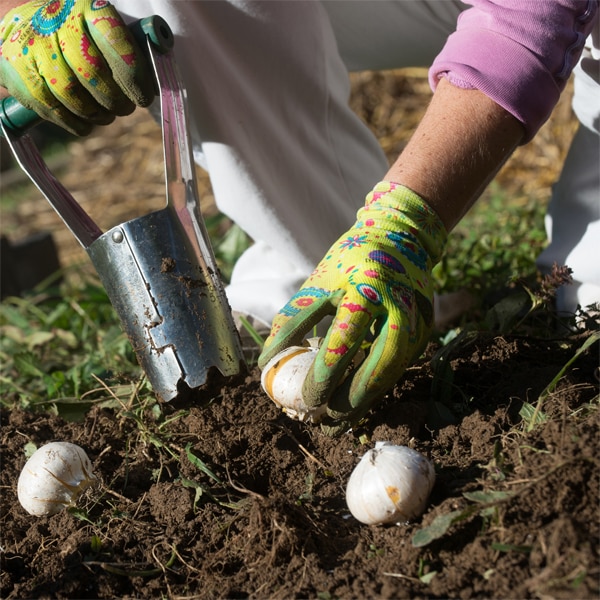As most gardeners learn, one person’s flower fantasy can be a free feast to some furry fiend. Animal pest problems occur in all seasons of the garden, but fall and spring are peak periods for plunder. Luckily these seasons, and fall in particular, are also the best times for beleaguered gardeners to mount a defense against foraging four-legged gourmands such as deer, squirrels, rabbits, voles, moles and other assorted animal pests.

In fall, a good garden clean-up tops the list of animal deterrents. After fall bulb planting, remove planting debris to rob squirrels of scent clues. (It’s scent, after all, that guides them to their hidden stashes — and to yours! They’re not relying on such memory cues as “three hops from the big tree on the left.”)
Also consider mulching later in the season. Mulch is useful to help retain soil moisture and maintain more constant cool soil temperatures. Apply mulch after weather turns cold. Mulching too soon only satisfies small creatures, who find earth-warmed mulch a great cozy place for winter tunneling and nesting.
The Furry Fiends
Who is it exactly that is nibbling the nasturtiums and devouring the daisies? Increasingly, in America, the culprits are likely to be deer. According to the New York Times “there are now more deer in the U.S. than when the Pilgrims landed in 1620.” A population of 27 million ranges across the land. And, increasingly, as the deer’s natural habitats are reduced by development, they are by no means restricted to remote woodlands. They’ve leaped into our backyards in what amounts in some parts of the country to a suburban invasion.
Squirrels and chipmunks are particular pests at fall flower bulb planting time. Count on them to promptly RSVP to fall garden parties serving tulip, lily or crocus bulbs — but not daffodils which have a terrible taste (hooray!).
Especially popular are gardens littered with bulb-scented debris (those little bags, the papery skins, and other tantalizing things). Yum, yum: just like a neon sign that reads “Good Eats.”
Deer are the greatest threat in the spring when, after a hungry winter, they look for anything green, young and tasty.
Rabbits have long been the vegetable gardener’s nemesis, but they’re happy to taste-test anything new and tender looking. Even if they really don’t love something, they just might chew on it for awhile to make sure.
Special fans of tree and shrub roots are found underground (where else!). Moles, voles and mice are the biggest (actually smallish) culprits. They also like roots of succulent plants and flower bulbs.
The groundhog, also called the woodchuck, is a tunnel master who finds any number of garden plants appealing both above and below the ground.
What To Do About Pesky Pests
To dispel any illusions at the outset: there is no magic bullet for the animal pest problem (save the sometimes tempting but not very humane option of actually using bullets). The best one can hope for is an “appropriate” pest management solution. Pest control options basically fall into five major categories:
- Barriers
- Sensory deterrents
- Vegetative deterrents
- Animal deterrents
- If you can’t beat ‘em, join ‘em.
About Barriers
Barriers are the most straightforward and many say the most effective deterrents. The strategy is to make it impossible for the critter to get to his dinner.
For deer, a fence is the best deterrent — a high one. A deer fence should be at least seven and a half feet high, and an additional overhang of chicken wire is a good idea. The most effective deer fence is a double fence. Deer can either jump something very high, or something very wide, but can’t do both at once. Two fences (one high and one moderately high) spaced about three feet apart are recommended. (Don’t worry, the deer see two fences and don’t jump, so they don’t get caught inside.)
Garden centers and other retailers also carry various types of plastic fencing and netting that might be appropriate. It is also possible to have an electric anti-deer fence installed. But this isn’t recommended for areas where there are small children or close neighbors.
For groundhogs and such, fences don’t need to be high, they need to be deep. About three feet deep should do the trick.
Chicken wire is another favorite barrier material. This can be used to form a cage over young plants, or an underground cage in which to protect bulbs from burrowers. It’s perfectly acceptable to place a sheet of chicken wire right on top of the planting. The bulbs will be smart enough to find their way right through it.
Some people take a casual (but very effective) approach when protecting bulbs from squirrels: they just throw on an old window screen after planting and take it up once the ground has settled or frozen.
Sensory Deterrents
Of course with all the fencing and caging, some people think the whole thing is too much, turning the garden into an outdoor Alcatraz. So what else is there?
Sensory deterrents seek to dissuade the unwanted garden diner by offending his sense of smell or taste or exciting his sense of fear and caution.
There are many products that help to deter these woodland creatures. Come in to either of our locations and talk to one of our staff to find the right thing for your yard.
Scattering clippings of human hair around the place (not always a good idea in urban settings, where squirrels may associate the smell of a human with food hand-outs).
Predator smells, such as lion’s dung or urine from the zoo, commercially available predator scents, or even human urine (there’s a guy out there who swears by it, but we didn’t visit his garden to confirm).
Egg mixtures, either the commercially available kind, or made up in your own kitchen. The idea is, well, rotten eggs. You get the idea.
Irish Spring soap (Why this brand? Who knows?) hung in little mesh bags around the edges of the garden.
All of the sensory deterrents have their champions and their detractors. Some swear by this one or that one, some say they’re all a bust. Often what works in one garden, doesn’t in another. Experimentation is the key — and certainly worth a try.
Vegetative Deterrents
The idea behind vegetative deterrents is to surround the plants your nocturnal visitors like to eat with ones they don’t or find repellent.
Deer, for example, don’t like thorny things. They also don’t eat anemones, astilbes, junipers, foxgloves, daffodils, ferns, grasses and a whole host of things. In fact there are enough things that deer don’t eat that you could build a cordon around your garden. Sort of a garden within a garden.
Fritillaria imperialis is also something deer don’t like and its strong skunky scent is repellent to many other creatures as well.
Squirrels and other small creatures won’t eat daffodils or other narcissi bulbs. These are good choices where pests are a problem.
Animal Deterrents
One could get very imaginative on the subject of animal deterrents, but why not just get a big dog? We’re not suggesting a “pit bull” or an attack dog. Just a big, frisky pup with a loud bark. The idea is to scare the deer, not hurt them. Animal shelters are full of good candidates who, in return for your love and care, will bark their heads off in defense of your vegetation.
As for guarding your garden, it’s a case where the bark is better than the bite – even a dog barking from the back porch will do the trick.
You Can Feed ‘Em to Beat ‘Em
Another school of thought holds that if you feed your animal friends first, they’ll leave your garden alone. Squirrel feeders and other animal feeders are widely available. The idea here is to make it so easy for them to eat that ravaging your garden seems too much effort.
Some swear by this. But others point out that by feeding the pest population, you encourage them to swell their ranks.
In the end, each gardener has to find his or her own answers. There’s really no one solution
This blog is courtesy of the International Flower Bulb Center








